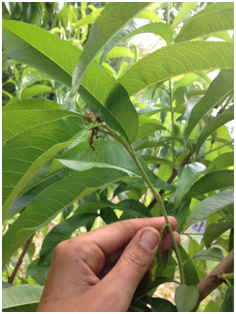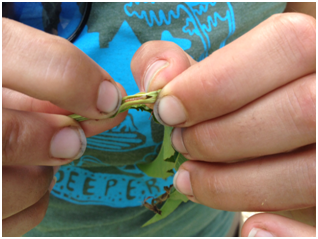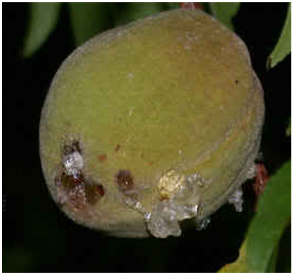The first Oriental Fruit Moths of the year often appear on our peach trees in early May. Although it is also known as Peach Tip Moth, this pest also affects other stone and pome fruit, and it can cause significant injury to the crop.
Oriental Fruit Moth (OFM), also known as Peach Tip Moth, have 4 -5 generations per year in Pennsylvania. Larvae overwinter and emerge as adults in early spring. Females then lay up to 200 eggs, usually during the month of May. The next 3-4 generations are produced throughout the summer and into September and October.
The earliest sign of an OFM infestation is leaf dieback on new growth of twigs (see pictures at top of post). First-generation larvae enter the twig near the tip of the shoot and bore into the new tissue, causing this “flagging.” In later generations, larvae may bore directly into the fruit.
This photo shows typical Oriental Fruit Moth damage on peaches. Later generations of OFM larvae can burrow into fruit pits resulting in perfectly healthy looking fruit that doesn’t last in storage. OFM can also affect apricots and other stone fruits and even sometimes apples and pears.
Management
Oriental fruit moths can be effectively controlled through the use of mating disruption. In a commercial orchard setting, either sprayable pheromones or hand-applied dispensers are utilized for this type of management. Ideally, orchards should be at least 5 – 10 acres in size for mating disruption to work, and pheromones should be put in the orchard in early spring.
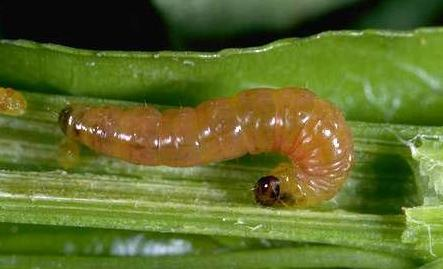
There are a number of other techniques that smaller urban or backyard orchardists can use. At this point in late spring, it is best to prune out OFM “flags” (these are the wilting ends of twigs infected by the first generation of larvae) in the new growth of branches. If the larvae are still in these tips, cutting them out and killing them will prevent the OFM from growing and reproducing.
Also remove and destroy any infected fruit that appear on the tree.
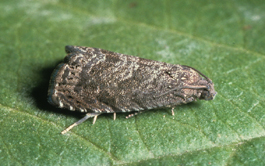
Spraying neem oil can help smother eggs and larvae and can be applied every 10 days (as always, avoid spraying in the heat of day or when pollinators are active). For bad infestations, Dipel (Bt) is an organic spray that is effective on all caterpillars. You can also try pheremone patches in September through November to reduce the last generation of moths and therefore the number of larvae for next year.
Brushing off any loose bark on the trunk can reduce hiding places for larvae and eggs. Wrapping cardboard around the trunk can also serve as a trap for larvae and eggs; such wraps should be checked and disposed of regularly if larvae are found. Since OFM larvae overwinter in soil, it can also be effective to cultivate the soil under the trees to a depth of 4 inches in early spring.
Last, pollinator garden plantings can help attract a wide variety of parasitic wasps that prey on OFM. Umbel flowers like fennel, dill, coriander, etc are especially suited for attracting these beneficial wasps.
More info: Green Harvest
This edition of POP TIPS prepared by Robyn Mello with assistance from 2015 POP Intern Nettie Baugher.
SUPPORT US! If you found this entry useful, informative, or inspiring, please consider a donation of any size to help POP in planting and supporting community orchards in Philadelphia: phillyorchards.org/donate.
